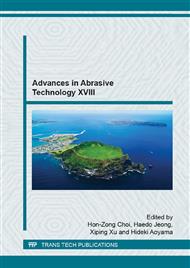[1]
Hailong WU Basic Research on CNC Abrasive Belt Grinding Process of Aero Engine Precision Forged Blade. 2012, China, Chongqing.
Google Scholar
[2]
HUANG Y, Huang. Z. Modern abrasive belt grinding technology and application in engineering. 2009, Chongqing.
Google Scholar
[3]
Dong Zhang, Chao Yun, Dezheng Song(2011) Dexterous space optimization for robotic belt grinding. Procedia Engineering 15: 2762 – 2766.
DOI: 10.1016/j.proeng.2011.08.520
Google Scholar
[4]
Hua CHAI(2013) Research on Belt Wear in Aero Engine Blade Processed by CNC Abrasive Grinding. China, Chongqing.
Google Scholar
[5]
Ali Boubakri, Amor Hafiane, Salah Al Tahar Bouguecha . Application of response surface methodology for modeling and optimization of membrane distillation desalination process. Journal of Industrial and Engineering Chemistry 20 (2014) 3163–3169.
DOI: 10.1016/j.jiec.2013.11.060
Google Scholar
[6]
V. Mugendiran, A. Gnanavelbabu. Parameter optimization for surface roughness and wall thickness on AA5052 Aluminium alloy by incremental forming using response surface methodology. Procedia Engineering 97 ( 2014 ) 1991 – (2000).
DOI: 10.1016/j.proeng.2014.12.442
Google Scholar
[7]
Bas.D., Boyacı, I.H., 2007. Modeling and optimization I: usability of response surface methodology. J. Food Eng. 78, 836–845.
DOI: 10.1016/j.jfoodeng.2005.11.024
Google Scholar
[8]
Yin, G., Dang, Y., 2008. Optimization of extraction technology of the Lycium barbarum polysaccharides by Box–Behnken statistical design. Carbohydr. Polym. 74, 603–610.
DOI: 10.1016/j.carbpol.2008.04.025
Google Scholar
[9]
K. Palani Kumar, Modelling and analysis for surface roughness inmachining glass fiber reinforced plastics using response surface methodology, Materials and Design, 28 (1) 2007 2611 -2618.
DOI: 10.1016/j.matdes.2006.10.001
Google Scholar
[10]
X. Ren, M. Cabaravdic, X. Zhang, B. Kuhlenkotter (2007) A local process model for simulation of robotic belt grinding. International Journal of Machine Tools & Manufacture 47: 962–970.
DOI: 10.1016/j.ijmachtools.2006.07.002
Google Scholar
[11]
H. Sevik, S. Can kurnaz, Properties of alumina particulate reinforced aluminium alloy produced by pressure die casting, Mater. Des. 279(2006): 676–683.
DOI: 10.1016/j.matdes.2005.01.006
Google Scholar
[12]
J. Sleziona, Influence ceramic particles on Al–SiC, Al–Al2O3 composites solidification, Arch. Mater. Sci. 16 (1995) 163–178.
Google Scholar
[13]
Guijian Xiao, Yun Huang(2014) Constant-load adaptive belt polishing of the weak-rigidity blisk blade. Int J Adv Manuf Technol. doi: 10. 1007/s00170-014-6724-4.
DOI: 10.1007/s00170-014-6724-4
Google Scholar
[14]
Zheng, X., Wang, X., Lan, Y., Shi, J., Xue, S.J., Liu, C., 2009. Application of response surface methodology to optimize microwave-assisted extraction of silymarin from milk thistle seeds. Sep. Purif. Technol. 70, 34–40.
DOI: 10.1016/j.seppur.2009.08.008
Google Scholar


